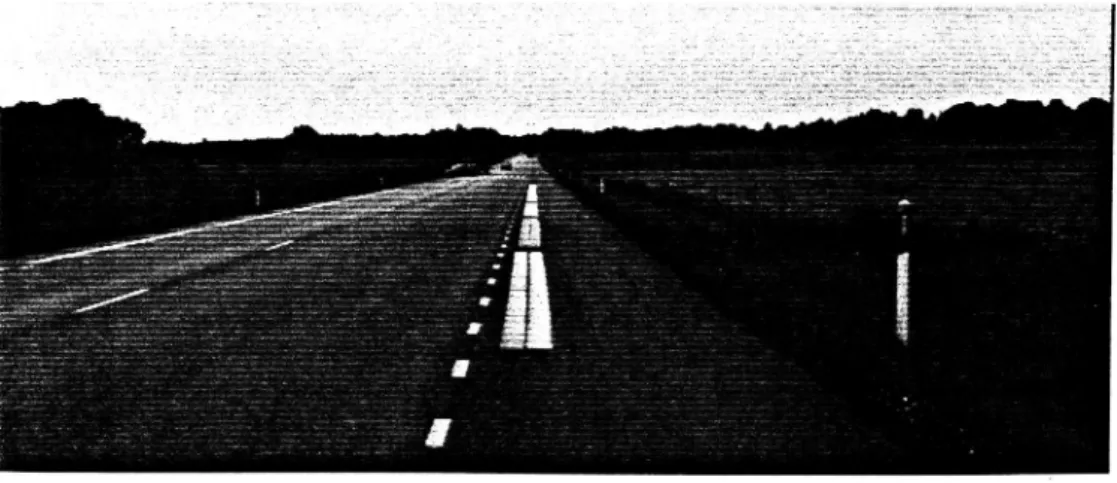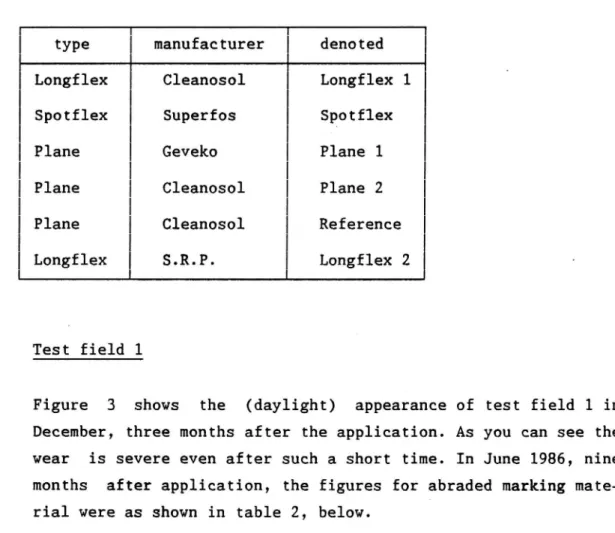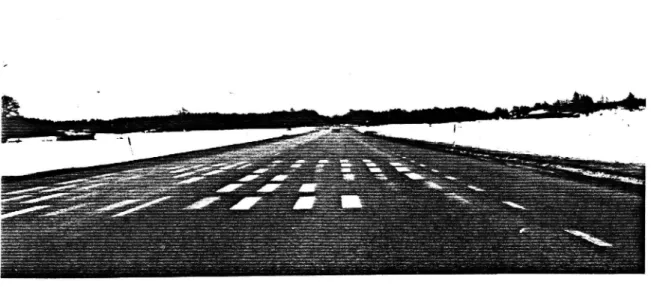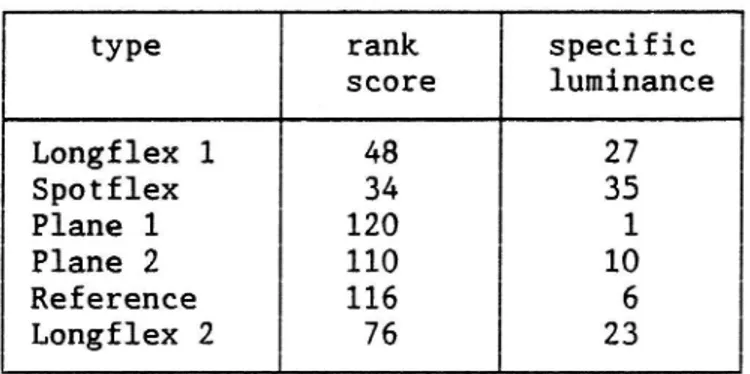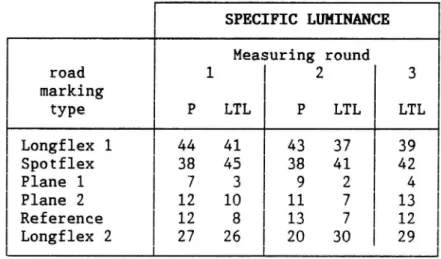VTInota1
No: TF 55 08A Date: 1988-10-31
Title: TESTS OF WET ROAD MARKINGS IN SWEDEN
Author: Sven-Olof Lundkvist'
Division: Road User and Vehicle Project no: 553 0504-9
Project title: Visual guidance of the road in night time traffic Sponsor: The National Road Admihistration
Distribution: free/restrieteé/
Swedish Road and Traffic Research Institute
(Lib
_
Statens v5 - och trafikinstitut
V g-ac/zfra k-
- Pa: 58707 Linképing. Tel. 073- 7752 00. Telex 50725 VT/SG/ Sg
TESTS OF WET ROAD EARRINGS IN SWEDEN
by Sven Olof Lundkvist
Swedish Road and Traffic Research Institute
SUMMARY
Road markings, designed to have a good function in darkness and wet weather conditions, were tested by VTI in Sweden during 1985 86. Five different types were compared with a conventional Swedish thermoplastic road marking.
The results showed that the corrugated road markings had consi-derably higher specific luminance, and thus better night time
visibility, than the conventional ones. However, the corrugated markings were very sensitive to wear after one winter they
were badly worn, while the reference was still intact.
In this test, the validity and reliability of the LTL-800 retro-Imeter were also evaluated on wet road markings.
In a new Swedish test another 12 types of road markings will be examined during 1988-89.
TESTS OF VET ROAD HARKINGS IN SWEDEN by Sven-Olof Lundkvist
Swedish Road and Traffic Research Institute
INTRODUCTION
It is not pleasant being a driver on Swedish roads in night-time traffic. Due to the climate most road maintenance must be car ried out in the summer period, May until September. If you drive along a Swedish road during that time, you will seldom have problems with the visual guidance; the sun is up 15-20 hours of the day, and if it is dark, you will mostly find that the road markings have a high degree of retroreflection and thus a good visibility.
Then the autumn and the darkness come, and along with that, the
wetness. Suddenly, the poor Swede finds that when he really needs the road markings they are almost completely invisible. Later the ice comes and the Swede puts on his studded tires. Those will guarantee that the markings are not only invisible, but also non existent within a couple of weeks. If one single marking would survive this treatment, the annihilation is com-pleted by the snow ploughs equipped with sharp steel blades.
SPECIAL SWEDISH PROBLEMS
The Swedish autumn/winter is, unfortunately, somewhat different from the. Central European. During the period November-February the main part of the total traffic is performed in night-time conditions. In the Stockholm area in December, for instance, the sun rises at about 9 a.m. and sets at 3 p.m. This means that most journeys to and from work are carried out during the dark hours of the day.
Also, during this period the road surfaces are often wet, due to rain or melting ice and snow. Thus the need for visual guidance is obvious during this time of the year a considerable part of the day is dark and the road pavement has a very low specific luminance because of specular reflection.
Also, during the winter, the road markings are severely worn by studded tyres and the steel blades of the snow-ploughs. This is a big problem for conventional, plane markings. For corrugated markings it is, of course, even worse.
THE SWEDISH TEST SITE, 1985
The first Swedish test site with road markings intended for wet conditions was laid in September 1985. It consisted of two parts, one for the evaluation of wear and for visual judgements of the visibility of the road markings, and the other for opti cal measurements. The traffic volume of the road where the mark ings were applied was approximately 5000 vehicles per day.
The test field comprised a total of six different road marking types. Three of those six types were corrugated, two were plane but designed to work in wet conditions and one the reference
Figure 1 shows test site 1, where the first transversal row
(closest to the camera) consists of type 1,2,...,6, the second row type 6,1,2,...,5 and so on so that every type is situated
exactly once in each lane.
Figure 2 shows test site 2. In this part each road marking was 12*O.5 metres in order to make it possible to make full scale Pritchard measurements with all the measuring area of the instrument within the marking.
Figure 1. Test site 1. The purpose of this tESt site was the evaluation of wear and to make judgements of visi-bility in wet conditions.
Figure 2. Test site 2, the purpose of which is testing the vali-dity and the reliability of measurement and wetting method.
RESULTS
The test contained the six road marking types stated in table 1. Table 1. Types of road markings in the test 1985-86.
type manufacturer denoted Longflex Cleanosol Longflex 1 Spotflex Superfos Spotflex
Plane Geveko Plane 1
Plane Cleanosol Plane 2 Plane Cleanosol Reference Longflex S.R.P. Longflex 2
Test field 1
Figure 3 shows the (daylight) appearance of test field 1 in December, three months after the application. As you can see the wear is severe even after such a short time. In June 1986, nine months after application, the figures for abraded marking mate
Figure 3. Test site 1 three months after the application of the markings.
Table 2. Percentage of road marking material abraded after nine months - one winter of wear.
type Z abraded Longflex 1 44 Spotflex 69 Plane 1 O Plane 2 8 Reference 0 Longflex 2 15
In figures 1 3 those road markings are in order from the right to the left in the first row, so that Longflex 1 is closest to the edge line and Longflex 2 closest to the centre line.
In December, three months after the application, subjective judgements and optical measurements of test field 1 were carried out when the road markings were wet.
The markings of each transverse row were ranked so that the brightest eas given rank 1. For each marking type the score of each of the six rows was summed up to get a rank score. This rank score is presented in table 3 along with the specific lumi-nance (retroreflexion) of the wet road markings. The specific luminance was measured with the LTL BOO retrometer. The markings were wetted artifically with a very simple method, described
Table 3. Rank score and specific luminance in (mcd/m2)/lux for the six road markings, measured three months after application. The rank score is a sum of 12 single ranks of two subjects at an observation distance of 30 metres. The specific luminance is a mean value of 12 markings.
type rank specific score luminance Longflex 1 48 27 Spotflex 34 35 Plane 1 120 1 Plane 2 110 10 Reference 116 6 Longflex 2 76 23
The lowest rank score for a type of marking is 24, which means that the two subjects have ranked this marking as the brightest in all 12 rows (six rows on each of the lanes). The highest value of the rank score is theoretically 144.
Test field 2
On the second test field, measurements of reliability and vali-dity have been made. Full scale measurements with a Pritchard photometer mounted at eye-level in a passenger car, have been compared with specific luminance values from the LTL BOO retro
meter.
The full scale Pritchard measurements were made at an
observa-tion distance of 50 metres, which is also the simulated distance of the LTL-BOO. The viewing angle was 19 minutes of arc, which
means that the measuring. area was an ellipsoid with the axis 11.7 and 0.28 metres.
8
The wettening method was very simple; on the road marking water corresponding to a rain shower of 4 mm was spread out with an ordinary watering-can. Measured values with this watering method were compared with specific luminance values measured during a
real rainfall.
In table 4 the specific luminance values of two measuring rounds with the Pritchard photometer and the LTL-800 are presented. Also, the specific luminance of artifically wetted markings is compared with values from measurements during a rainfall.
Table 4. Specific luminance of wet road markings measured with the Pritchard photometer mounted at eye level in a passenger car and with the LTL 800. The Pritchard figures are mean values of two road markings (12*0.5
metres). The LTL-800 values are mean values of five
measurements on each of those two markings. In mea-suring rounds 1 and 2, the road markings were artifi-cally wetted, while measuring round 3 was on a day
with heavy rain. In the table Pritchard and LTL-800
are denoted "P" and "LTL" respectively. Specific lumi-nance in (mcd/m2)/lux. SPECIFIC LUHINANCE Measuring round road 1 2 3 marking type P LTL P LTL LTL Longflex 1 44 41 43 37 39 Spotflex 38 45 38 41 42 Plane 1 7 3 9 2 4 Plane 2 12 10 11 7 13 Reference 12 8 13 7 12 Longflex 2 27 26 20 3O 29
According to table 4 the agreement between the Pritchard and the LTL-800 values measured, is good. This indicates that the vali-dity of the LTL 800 retrometer is good. Also the repeatability of the measuring-values of LTL 800 is high; thus the instrument
9
and the watering procedure have a high reliability. The corre lation coefficient between the two measuring rounds, which tells the reliability, is as high as 0.987.
If we look at the function of the markings, we find that the specific luminance values measured are rather low. In table 4 mean values of the two measuring rounds for both wet and dry markings are presented. The quotient between the specific lumi-nance in wet and dry condition, 5, is also shown in this table. This quotient tells us the function of the road marking in the wet condition compared to the dry condition.
Table 4. Comparison between the specific luminance of dry and wet road markings. 8 is the quotient between the spe-cific luminance in wet and dry conditions. Measure-ments with the LTL 800. Specific luminance in
(mcd/m2)/lux.
road SPECIFIC
marking LUMINANCE 6 type dry wet
Longflex 1 156 39 0.25 Spotflex 72 43 0.60 Plane 1 6O 2 0.03 Plane 2 194 8 0.04 Reference 162 8 0.05 Longflex 2 114 28 0.25
COMMENTS TO THE RESULTS
The results presented above show that measurements with the LTL-800 retrometer and with the very simple wettening method described, have high validity and reliability.
The optical function of corrugated road markings was, in wet weather conditions, considerably better than the function of conventional, plane road markings. Plane markings lost more than
10
90% of their specific luminance in heavy rain, while Spotflex, for instance, lost only about 40% of its specific luminance. The absolute values of the specific luminance were very low for the plane markings. The corrugated ones had somewhat higher values, but not high enough from a traffic safety point of view. In the Nordic countries (Denmark maybe excepted), the problem of wear is severe. In the Stockholm area approximately 80% of the passenger cars are equipped with studded tires during the winter
period. Also, because of the tough snow and ice conditions, the
ploughs have blades made of steel. This means that the road marking materials are exposed to considerable wear and naturally the corrugated markings are particularly sensitive to this treatment. This is the result of the first test carried out. The two types of Longflex and the Spotflex were worse than the plane
ones after one winter of wear.
THE SWEDISH TEST, 1988
Since the first Swedish test of the function of road markings in
wet conditions was carried out in 1985-86, efforts have been
made by the producers to provide improved materials. A test field with some new types of road markings is to be laid at the end of August 1988. It will consist of 12 different marking types. On this test field measurements of the specific luminance and wear will be made during at least one winter, and hopefully also during the winter 1989-90.
